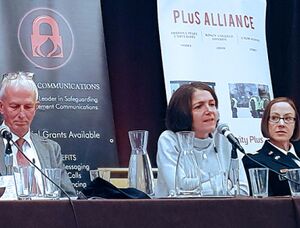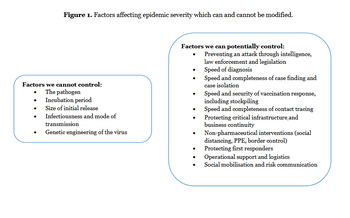Exercise Mataika
 | |
| Date | August 16 2018 |
|---|---|
| Location | Sydney, NSW, UNSW, Australia |
| Participants | Devina Nand, Fiji Ministry of Health and Medical Services, Craig Schramm, Australian Defence Forces, Michael Butel, United States Indo-Pacific Command, William Rawlinson, NSW Health, Michael Baker, University of Otago, Tomasz Kiedrzynski, New Zealand Ministry of Health, Alexander Rosewell, University of New South Wales, Jesper Elsgaard, Bavarian Nordic, Louise Fonua, Ministry of Health Tonga, John Michael Lane |
| Perpetrators | Raina MacIntyre, David Heslop |
| Interests | • pandemics • smallpox • mathematical modelling |
| Description | 2018 "pandemic" exercise planning for non-pharmaceutical interventions like social distancing and face masks, and contact tracing. "Dissent is quashed using various means" |
Exercise Mataika was a 2018 "pandemic" planning exercise held in Australia. Using mathematical modelling to create scary-sounding scenarios[1], it then used these rigged science estimates to indoctrinate the participants to accept the need for interventions like social distancing and face masks, and contact tracing - and always a "vaccine" as the only possible final solution,"[2][3] exactly like under the declaration of Covid two years later. "Dissent is quashed using various means"[4]
Scenario
Rather than seeing the scenario as an actual possibility, it is better to consider it as a way to indoctrinate organizations mid-level management in the procedures wanted by the deep state, where what is described as "problems" are in fact the desired outcomes. In these simulations, (coerced) mass deployment "vaccines" are always considered the final way out.[1]
Mathematical modelling of smallpox transmission was used to simulate the epidemic under different conditions and to test the effect of interventions.[1]
- After report from local health authorities, a team from the WHO is dispatched to Fiji to conduct testing. 13 days later, WHO soon declares a Public Health Emergency of International Concern. By then, the health system is overwhelmed, with multiple hospitals treating cases and media reports causing public panic.[1]
- Forensic investigation by local agencies and Interpol identifies a bioterrorism attack to have taken place at Nadi International Airport in Fiji on August 1st, with many people infected simultaneously and some travelling onward to other countries on day zero.[1]
- It is spread by the respiratory route and rapidly propagates in a largelynon-immune population[1].
- Law enforcement investigations identify the method of attack and uncover possible planning for a second or multiple other attacks on the Dark Web. Identification of perpetrators is difficult, but there appears to be a large network of global colluders, which are using cryptocurrency for financial transactions to support their activities.[1]
- Globally, critical delays occur in coordination of the response, including the need to vaccinate first responders before they can deploy. Staff need to be trained in vaccination procedures, care of the vaccination site and assessing vaccine take. Vaccinating the vaccinators and procuring supplies of bifurcated needles cause some delays. As the epidemic escalates, hospital beds reach capacity and other industries are affected by severe absenteeism. Lack of resources, including human resources, is a major problem. Modelling shows that the epidemic is most sensitive to case isolation, contact tracing and vaccination, and speed of response. Speed of response for isolation, contact tracing and vaccination is most critical in the early stages of the epidemic.[1]
- In a worst-case scenario, at the peak of the epidemic, worldwide, only 50% of smallpox cases are isolated (mostly through use of community volunteers and use of makeshift buildings as isolation facilities) and only 50% of contacts are tracked and vaccinated, causing a catastrophic blow-out in the epidemic.[1]
- Critical infrastructure, travel and trade are affected, and countries scramble to get access to limited antiviral drugs, vaccine and personal protective equipment supplies.[1]
- Mass gathering bans are implemented in Fiji and other countries.[1]
- In the final phase of the epidemic, which becomes a pandemic, the workforce is decimated, leaving critical infrastructure, transport, power, communications and food supplies compromised.[1]
- Dissent is quashed using various means and penalties for insubordination are increased in uniformed services. Key modern systems become unreliable, including wireless and data communications, economy and banking (cash supply), replacement parts and manufactured items, processed food, and medications.[1]
- accelerated vaccine development has been approved, with mixed academic and public reaction. Ethicists are alarmed about the possible harms of rapidly implementing human experimentation and caution that the risks may outweigh the benefits. Misinformation and poor crisis communication exacerbate the situation.[1]
Participants
The exercise was conducted by The National Health and Medical Research Council (NHMRC) Centre for Research Excellence, Integrated Systems for Epidemic Response, with input from the Ministry of Health and Medical Services Fiji. The simulation was designed by Professor Raina MacIntyre from the Kirby Institute at UNSW.[1]
Unnamed "stakeholders from government and non-government organisations from Australia, New Zealand, several Pacific Island countries (PNG, Tonga, Vanuatu, Fiji, FSM, Samoa, Guam), the United States of America (USA) as well as industry and non-government organisations based in the United Kingdom, Singapore, Denmark and Switzerland were present."[1]
Sponsor
| Event | Description |
|---|---|
| Emergent BioSolutions | "One of the most politically-connected yet scandal ridden vaccine companies in the United States" |
Known Participants
3 of the 19 of the participants already have pages here:
| Participant | Description |
|---|---|
| Australia/Military | |
| University of New South Wales | Sydney technological university with military ties |
| University of Otago | University in New Zealand |
References
- ↑ a b c d e f g h i j k l m n o p https://jglobalbiosecurity.com/index.php/up-j-gb/article/view/10/69
- ↑ https://jglobalbiosecurity.com/index.php/up-j-gb/article/view/10/
- ↑ https://www.acmc.gov.au/sites/default/files/2024-02/Enhancing%20Multi-Agecncy%20Biological%20Threat%20Preparedness%20and%20Response%20in%20Fiji%20FINAL%202.pdf
- ↑ https://jglobalbiosecurity.com/index.php/up-j-gb/article/view/10/70
